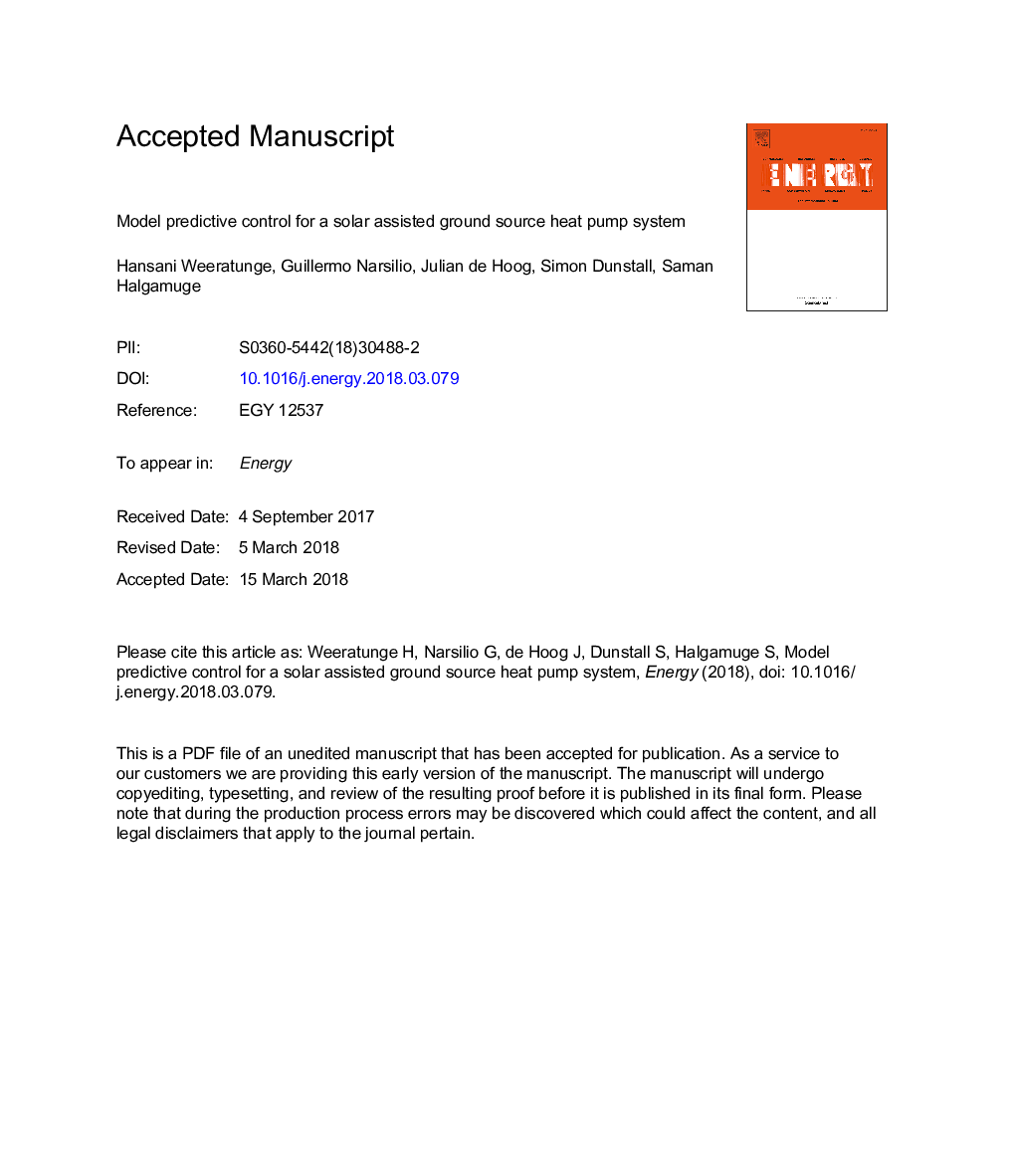| کد مقاله | کد نشریه | سال انتشار | مقاله انگلیسی | نسخه تمام متن |
|---|---|---|---|---|
| 8071713 | 1521398 | 2018 | 27 صفحه PDF | دانلود رایگان |
عنوان انگلیسی مقاله ISI
Model predictive control for a solar assisted ground source heat pump system
ترجمه فارسی عنوان
کنترل پیش بینی مدل برای یک سیستم پمپ گرما با منبع خورشیدی کمک می کند
دانلود مقاله + سفارش ترجمه
دانلود مقاله ISI انگلیسی
رایگان برای ایرانیان
کلمات کلیدی
پمپ حرارتی منبع زمین، ذخیره سازی گرم، حرارتی خورشیدی، کنترل پیش بینی مدل، برنامه ریزی خطی زنجیره ای مختلط،
ترجمه چکیده
افزایش علاقه به هزینه و بهره وری انرژی برای گرمایش، تهویه و سیستم های تهویه مطبوع ساختمان ها از آنجایی که این مسائل بین 25 تا 40 درصد از کل تقاضای انرژی ساختمان را تشکیل می دهند، افزایش یافته است. انرژی خورشیدی به سیستم های گرمای پمپ های منبع زمین کمک می کند که انرژی خورشیدی و زمین گرمایی را با توجه به راندمان بالاتر و تنوع عملکردی آنها نسبت به سیستم های معمولی افزایش می دهد. این مقاله یک رویکرد برنامه ریزی خطی مختلط ترکیبی را برای به حداقل رساندن هزینه عملیاتی یک سیستم پمپ گرم کننده منبع خورشیدی با توجه به زمان مصرف برق (حداکثر، حداکثر) می دهد. دو نوع تنظیمات سیستم به منظور بررسی تأثیر ذخیره سازی حرارتی در سیستم مورد بررسی قرار گرفته است. دو هدف متفاوت مورد بررسی قرار گرفته است: به حداقل رساندن مصرف برق و هزینه های عملیاتی. نتایج نشان می دهد که سیستم دارای ذخیره سازی حرارتی یکپارچه منجر به اصلاح پیک اصلاح شده است که نیاز به تولید انرژی گرانقیمت گران قیمت را برای شبکه کاهش می دهد و هزینه عملیاتی آن را به میزان 7.8٪ کاهش می دهد.
موضوعات مرتبط
مهندسی و علوم پایه
مهندسی انرژی
انرژی (عمومی)
چکیده انگلیسی
There has been an increased interest in cost and energy efficiency for heating, ventilation, and air conditioning systems for buildings since these are responsible for between 25% and 40% of total building energy demand. Solar assisted ground source heat pump systems which combine solar and geothermal energy are gaining attention due to their higher efficiency and greater functional diversity when compared with conventional systems. This paper presents a mixed integer linear programming approach to minimize the operational cost of a solar assisted ground source heat pump system, considering time-of-use electricity price (peak, off peak). Two types of system configurations are investigated in order to examine the effect of thermal storage in the system. Two different objectives are explored: minimizing electricity consumption and operational cost. The results indicate that the system having integrated thermal storage leads to improved peak shaving, which reduces the need for expensive peak electricity production for the grid, and has a reduction of operating cost by 7.8% when it is optimized for minimal cost.
ناشر
Database: Elsevier - ScienceDirect (ساینس دایرکت)
Journal: Energy - Volume 152, 1 June 2018, Pages 974-984
Journal: Energy - Volume 152, 1 June 2018, Pages 974-984
نویسندگان
Hansani Weeratunge, Guillermo Narsilio, Julian de Hoog, Simon Dunstall, Saman Halgamuge,
